Contents
As an affiliate marketer, you’re always looking for new types of content to produce. Content that is both valuable to your readers and has the potential to generate affiliate revenue through recommendations.
Introducing: the Listicle format. Writing listicle-style articles is a great way to leverage competitor brand awareness and get you in front of people who are ready to buy.
In this post, we’ll cover the ins and outs of listicle writing, including:
- What is a listicle?
- Why does “alternatives” listicle writing work for affiliate marketing?
- How to write an alternatives listicle in 4 steps.
- How to find alternatives keywords to target.
At the end of this article, we’ll also provide 6 examples of alternative listicles within both the software and physical product markets. Without further ado, let’s get started!
What is an Alternatives Listicle?
In short, a listicle is a blog article that uses a list format. Furthermore, an alternatives listicle is used to suggest other options and solutions.
Let’s say, for example, you love watches. You dream of one day owning a Rolex Submariner. Although, because they’re so expensive, you search for “Rolex Submariner alternatives” to find watches that are similar, but cheaper.

This is very common across physical products and brands, as well as software products. Additionally, the more popular the product, the more search demand there’ll be for alternatives.
These types of keywords present a big opportunity for your search engine optimization (SEO) and content strategy.
Why Does Alternatives Listicle Writing Work for Affiliate Marketing?
For affiliate marketers, alternative keywords are a goldmine. These are high intent keywords.
When someone searches for an “alternative”, they’re at the bottom of the funnel. The searcher knows their problem or desire, has started their research, and knows some of the solutions. Most likely they’ve discovered the market leaders, but they aren’t quite a perfect fit.
They’re ready to buy if they can just find the right alternative.
You’ll see this most commonly with products, brands, and even categories. By “category”, we mean something like “kettlebell alternatives” (not a specific product or brand, but still an indication of the solution they’re looking for).
Here are more example searches:
- Software products: Trello alternatives, Mailchimp alternatives, Netflix alternatives
- Physical products: iPad alternative, GoPro alternatives
- Brands: Rolex alternatives, Under Armour alternatives
- Categories: kettlebell alternatives, sugar alternatives for baking
As well as for affiliate marketing, this SEO content strategy works extremely well for challenger brands. Newer products can leverage their bigger competitors’ brand awareness by positioning themselves as an alternative.
How to Write an Alternatives Listicle in 4 Steps
Ranking for an alternatives keyword is not nearly as easy as it once was. 5-10 years ago, you could blindly throw out a list of solutions, copy and paste the features from the seller’s own sales page, optimize your page title, and then expect to rank number one.
Apart from very, very low competition niches, that won’t cut it these days. Especially since Google’s product reviews update in April 2021, it’s more important than ever to really add value to your audience.
Instead of creating a random list of products, you’ll need to think about the different use cases. Then, you’ll want to write out relatable reasons why each product would be best for each situation.
Here are 4 simple steps you can take to put together a killer listicle that ranks.
1. Identify the Product’s Strengths
The first step is to understand what makes a product attractive. You’ll want to narrow in on the specifics of a product and how people are basing their search for alternatives.
For example, there tends to be a distinctive reason why someone chooses to search for “Trello alternatives”, as opposed to “Kanban board software” or “task management tools”. Perhaps Trello offers a bunch of strengths this person is looking for, i.e.:
- A generous free version
- Trello-style task management
- A simple interface
For whatever reason, in this scenario, Trello is just not quite right for the consumer. This brings us to the next step – figuring out why.
2. Identify the Reasons to Seek Out an Alternative
The second step is to figure out why someone would look for an alternative – this typically includes researching the drawbacks or limitations of a product.
Sometimes the keyword spells it out for you. Instead of typing “Mailchimp alternatives”, someone might search for “cheaper Mailchimp alternatives”. In that case, this step is redundant, and you already know the motivation: cost.
Generally though, we don’t know the motivation. The search is just product alternatives, with no additional context, so we need to cover our bases.
Doing this will make your article more useful, more likely to rank, and it’ll convert better if a reader can find the perfect solution for their use case. To get you started, here are some common drawbacks you might identify:

3. Research Products in the Niche that Fix Each Drawback
For each of the potential drawbacks, now it’s your job to suggest an alternative. Continuing on with the Trello alternatives theme, you might suggest something for use cases like:
- A tool that is better for a specific niche (i.e. better for developers or designers)
- Something with a lower starting price for paid plans
- Software that is better for resource/capacity planning
And so on.
Then you can list out the suggestions and clarify who and what each product is best for with a short summary. It’s common to pull out the key details and features of each product, but make sure that’s not all you do. Remember to add more value beyond what users can already find on the brand website.
Here are some ideas:
- Link it back to the original product. If you choose this suggestion (e.g. Asana as a Trello alternative), what will you lose? What will you gain?
- Comment on the product improvement history. Have there been recent updates or new models released?
- What are the other key decision-making factors? For example, if you’re writing about kitchen knives: which steel is used, and what does that mean for the user? How easy are they to sharpen and look after? etc.
4. Provide a Short Version
Both at the start and the end of an article, it’s worth providing a quick overview. Here are a few examples of the different types of short product summaries:
The Absolute Basics
For this summary method, you’ll literally just note the criteria in which each product is the best alternative and the product name:
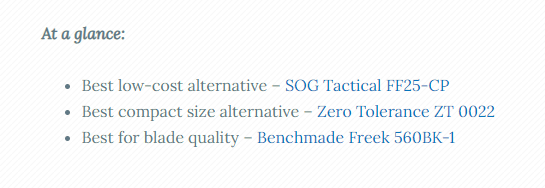
You can add this at the beginning of an article in a matter of seconds.
Plain Text with Short Summaries Per Product
With this type of summary, you’ll need to provide slightly more information but still aim for the minimum amount of details a reader might need to make their decision. You can also set up your article to make it where readers can either click now or choose to scroll down and get more details:
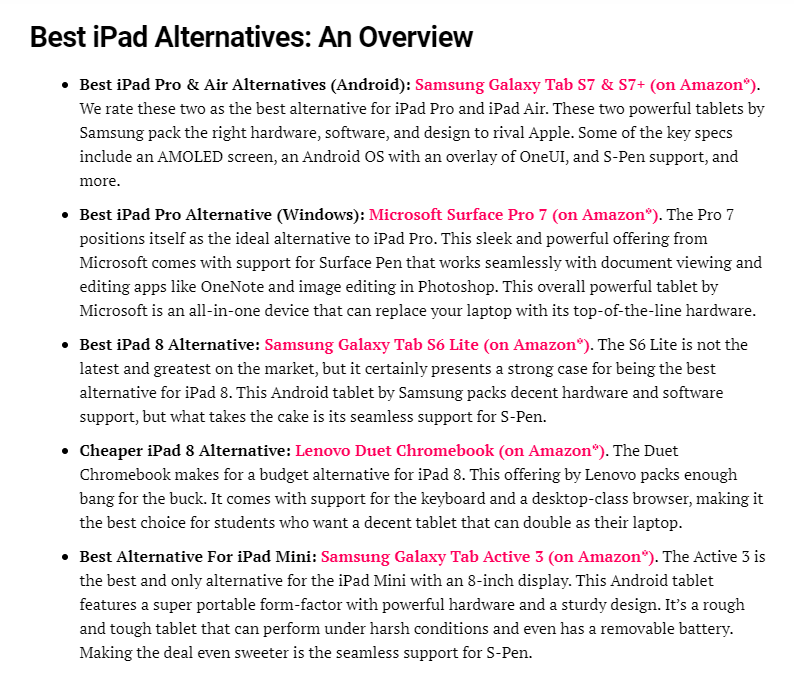
Even with the larger sections of text, this is still very quick and easy to implement at the top of your listicle.
An Overview Table
This summary style is highly visible and will most likely require a plugin or software of some kind to achieve. Although, the extra prep work is worth it because tables and charts often lead to higher conversion rates.
This is a quick and noticeable way to show the alternatives with a high-level overview of their features:
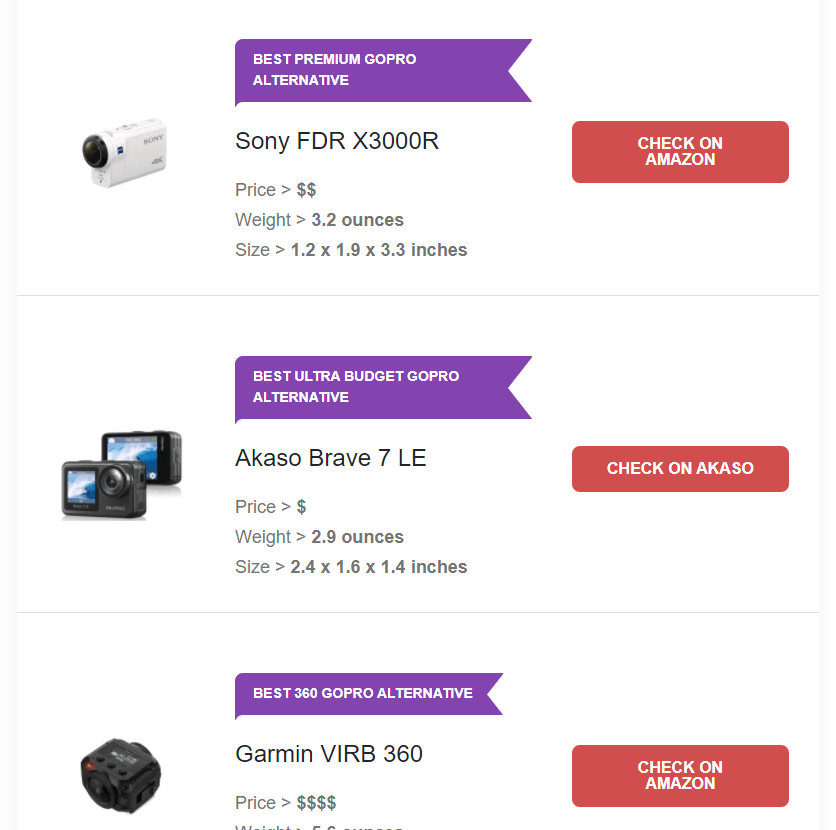
When placing a table at the beginning of your post, many readers won’t even read the actual article. If you make it obvious what the top alternatives are straight away (above-the-fold), you’re likely to get more clicks and fewer bounces.
Moosend has a more detailed version of this in their Mailchimp alternatives article, with a clickable PDF guide summarizing the options:
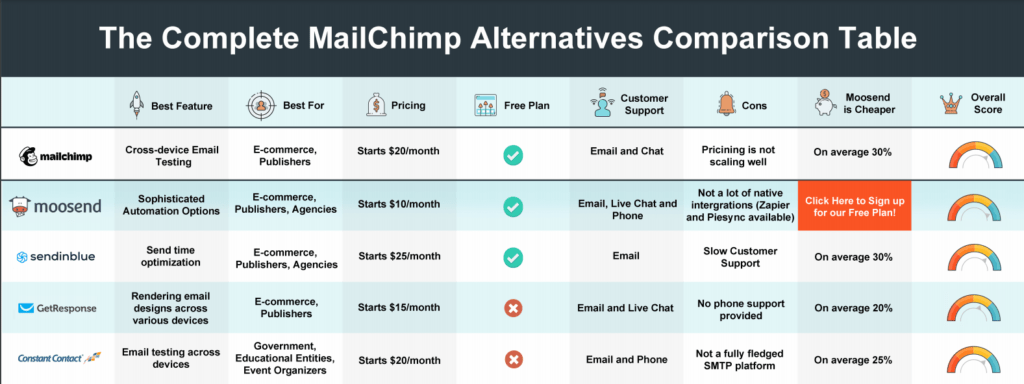
Try implementing this summary method and test for yourself whether your affiliate link click-through rate (CTR) increases.
How to Find Alternatives Keywords to Target
Next up, let’s take a look at how you can find “alternatives” opportunities for your niche.
First, you’ll need a keyword research tool. For the examples in this article, we’ll be using one of our favorites, KWFinder by Mangools, on account of how great it is at finding low-volume keywords.
To get started, you’ve got two main strategies to use: to search by keyword, or, to analyze competitor domains.
Search by Keyword
Performing a keyword search is exactly as it sounds. With this strategy, you’ll go through your initial ideas, searching by keyword.
For example, let’s say you’re in the email marketing space. You might start with Mailchimp – one of the most well-known brands in this space.
Using Mangools’ KWFinder, you can type “Mailchimp alternatives” to see the average search volume per month, together with the trends over time, and even get a look at the current SERP:

You’ll also find the longtail variants that have a high search demand (if there are any).
In this case, we have keywords like “best Mailchimp alternatives”, as well as “cheaper Mailchimp alternatives”, and “open source Mailchimp alternatives”:
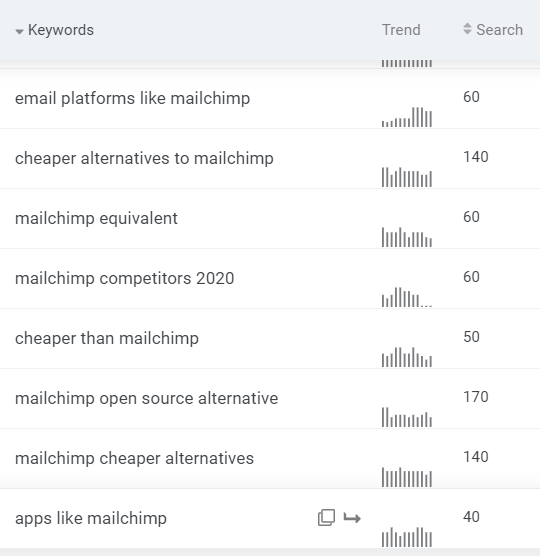
From here, you can choose to create content for a keyword with higher potential, but also higher difficulty (Mailchimp alternatives). Or, choose one of the lower potential alternatives that would be easier to rank for, i.e., “Mailchimp open source alternative”.
Using a brand keyword works especially well with this strategy too. Simply searching the brand name and adding “alternatives” will give you a bunch of content ideas.

Searching “Rolex alternatives” as an example gives us a long list of related keywords. These are all article ideas for specific Rolex models, in order of how much search volume they get.
Search by Competitor Domain
A second option is to reverse engineer what is working well for your competitors.
This can be great for getting new ideas you may not have thought of before; however, it does come with the condition that you’re guaranteed to have at least some competition.
Start by dropping a competing domain into your keyword research tool. You’ll get a long list of all the keywords that domain or URL ranks for. Next, you can filter it down to only include keywords containing the term “alternative”.
Here’s what that looks like in KWFinder:
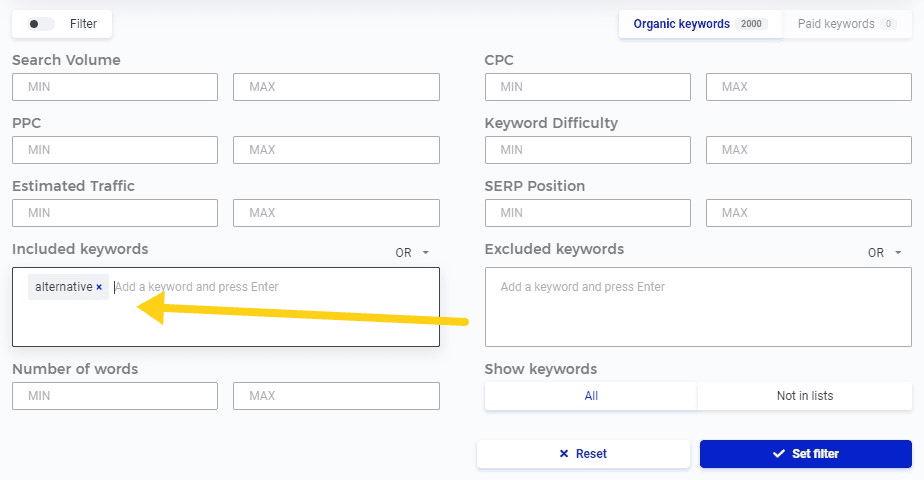
Doing so, you’ll get a list of keywords that domain ranks for that includes “alternative”:
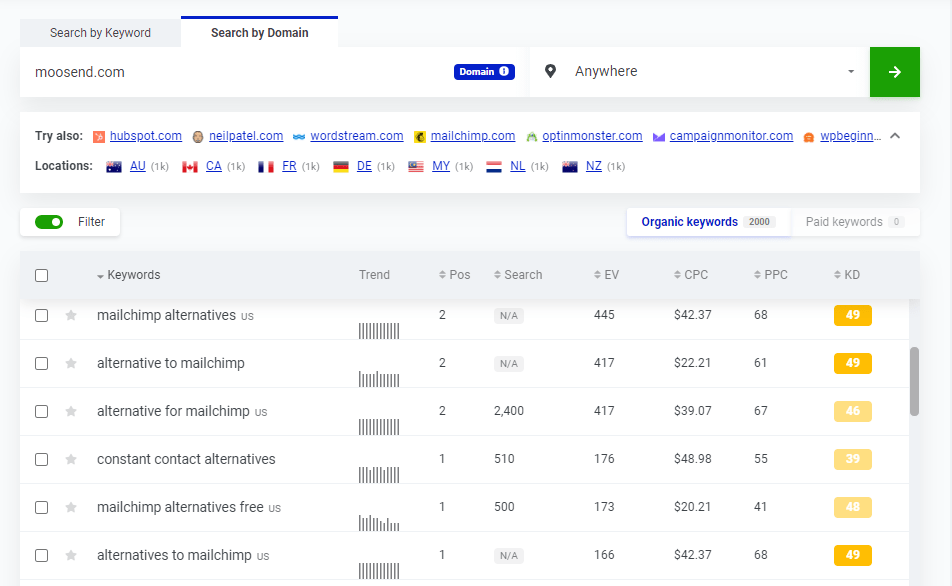
Bonus Tip: Check Your Google Search Console Data
Lastly, here’s one worthwhile keyword exercise you can do without any third-party software. Just a heads-up, it won’t work well for brand new sites, but if you’ve been publishing content for a while, it’s worth a check.
Google Search Console is a free service that can help you monitor, maintain, and troubleshoot your site’s visibility in Google. After you create an account and add your website property, you can get instant access to this powerful keyword functionality.
Open up your Performance report in Search Console and add a filter for queries containing “alternative”:
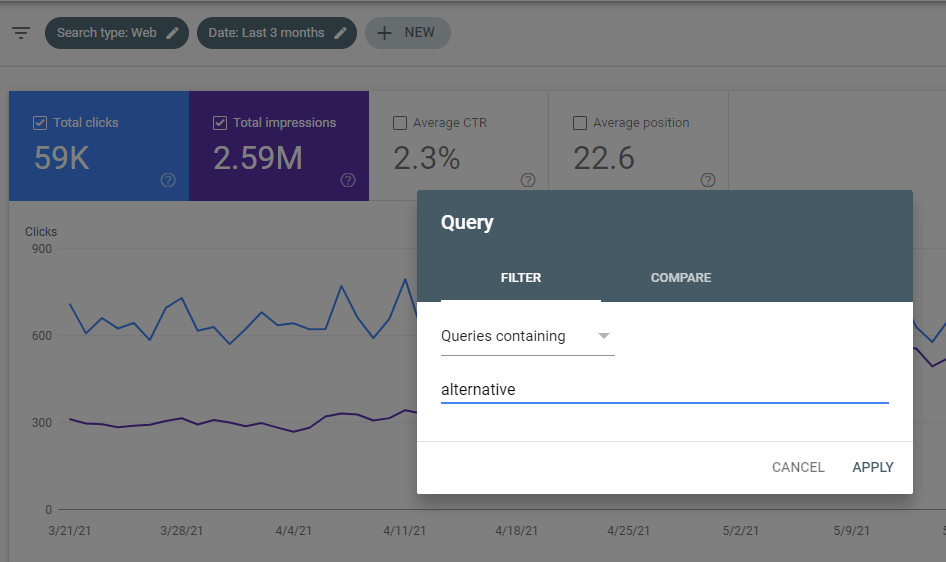
It’s common to see sites that have picked up impressions inadvertently for keywords they would otherwise never think to pursue.
That being said, you may also find that this method can find keywords other research tools have missed. This would be considered a great opportunity, because if your competitors are using the same SEO tools, they wouldn’t have found them either!
Once you’re done, you can easily organize these opportunities in one place using either a Google Sheet, mind mapping software, a task management tool – whatever works for you.
The last thing to do is assess keyword difficulty and decide which keywords to prioritize. Don’t just rely on the keyword difficulty metric, you’ll also want to manually analyze the backlink profile of the current ranking pages.
Some helpful hints to keep in mind:
- The more search volume there is, the tougher it’s likely going to be to rank.
- If you’re on a relatively new domain without many backlinks, try to find very low competition keywords to get some traction with first.
6 Alternatives Listicle Examples
After all of that, now we’ll show you 6 real-world examples that you can check out before starting your own listicle. These are broken down into 3 SaaS product examples and 3 physical product examples.
SaaS Alternative Listicles
1. Ahrefs Alternatives by Marketing Arsenal
In this affiliate article, the most common reasons to seek out Ahrefs alternatives have been identified around pricing and features:

2. Trello Alternatives by ClickUp
As a tool in the productivity space, ClickUp is a Trello alternative. Therefore, it makes sense that they would want the opportunity to present themselves as such.
In the full article, ClickUp identifies the drawbacks of Trello, as well as what you should look for in an alternative. Before, naturally, pitching themselves as the #1 alternative:
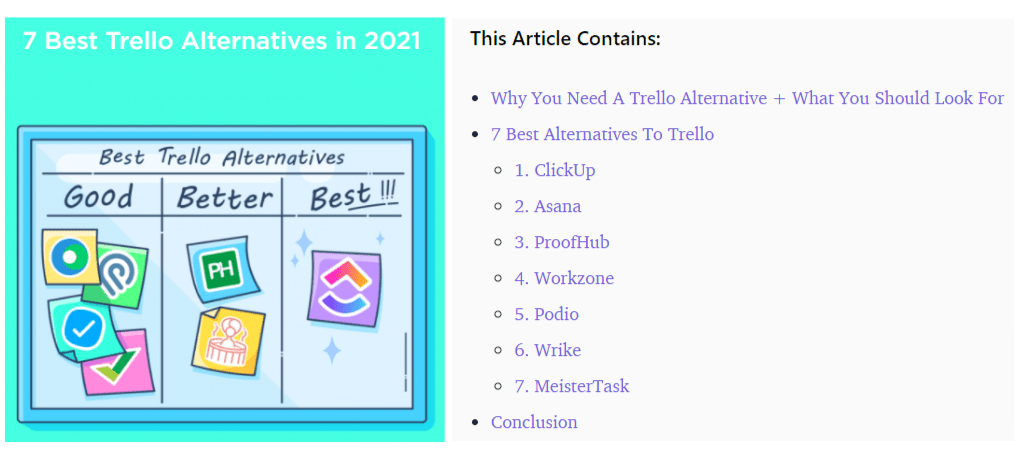
3. Hotjar Alternatives by CrazyEgg
Similar to ClickUp’s listicle above, here, CrazyEgg is pitching themselves as a Hotjar alternative.
They start by categorizing tools, since Hotjar has several features. Some tools may replace one feature of Hotjar, but not others (e.g. heatmaps, but not a/b testing).
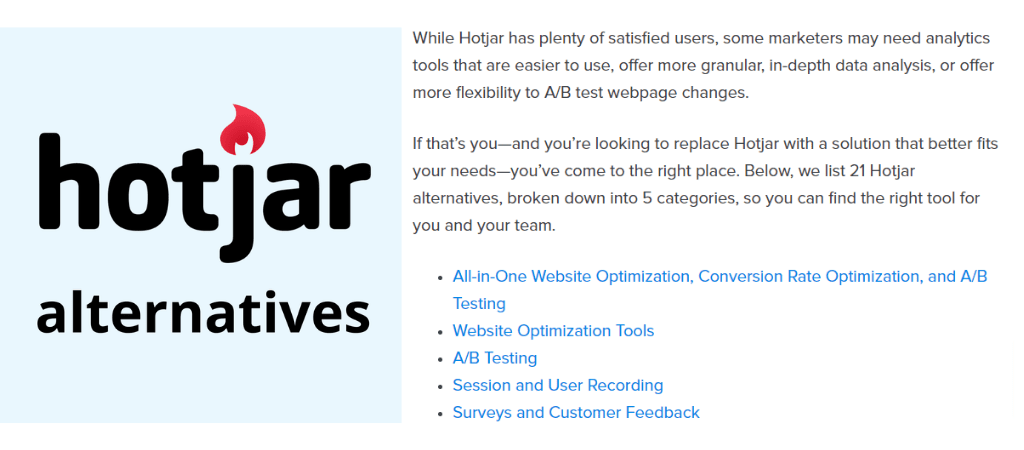
Then, they go through and list each tool with bullet points and a short summary. Simple, but effective.
Physical Product Alternative Listicles
1. Rolex Explorer Alternatives by Watch & Bullion
Here, the alternatives are categorized by affordability:

6 alternatives were identified, primarily based on their appearance. The majority of people reading this article are going to be those who like the look of an Explorer, but can’t afford the $6.5k+ price tag.
Breaking the products down into budget, mid-range, and premium alternatives helps the reader quickly skip to whatever suits them best.
2. iPad Alternatives by MyNextTablet
This article acknowledges that other tablets on the market are better than the iPad in some ways, but not others:

It’s a good example of how to tackle more general searches. There’s a ton of different iPads, so your suggestions must be dependent on which specific model the reader is considering.
They identify alternatives for different models such as the iPad Pro, or the iPad mini, and add additional suggestions such as cheaper alternatives too.
3. Benchmade Bugout alternatives by Knives Advisor
This alternatives listicle is similar to the Rolex example, in that Benchmade is a premium brand. Fans who would like to buy a Benchmade knife may not be able to afford one and will look for alternatives.

Summary
If you haven’t experimented with alternatives listicle writing yet, we encourage you to check out the opportunities in your niche.
Research what people are searching for in Google, starting with the market leaders. Then:
- Identify the product’s strengths.
- Identify the reasons to look for an alternative.
- Recommend products to fix each reason/drawback.
By following these steps, you’ll be putting your content a step ahead of the competition, and giving your readers a great experience.
If you liked this article, be sure to follow us on Facebook, Twitter, and LinkedIn! And don’t forget to subscribe in the box below.









Leave a Reply